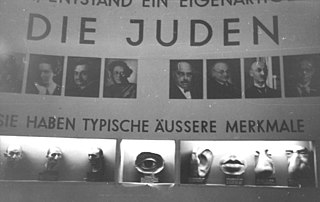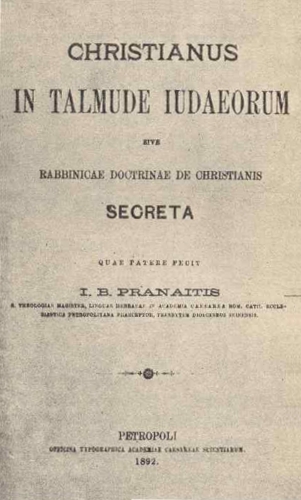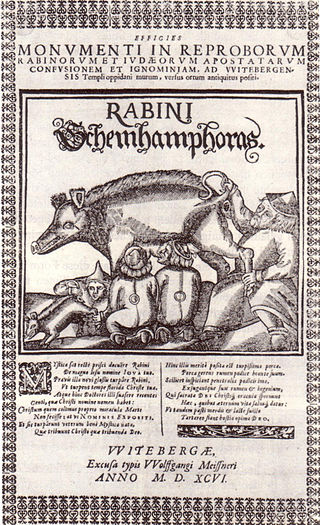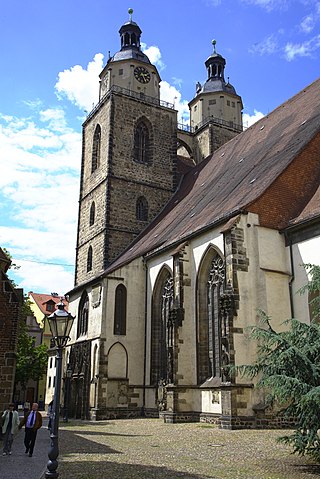Some Christian Churches, Christian groups, and ordinary Christians express religious antisemitism toward the Jewish people and the associated religion of Judaism.
Antinomianism is any view which rejects laws or legalism and argues against moral, religious or social norms, or is at least considered to do so. The term has both religious and secular meanings.
The history of antisemitism, defined as hostile actions or discrimination against Jews as a religious or ethnic group, goes back many centuries, with antisemitism being called "the longest hatred". Jerome Chanes identifies six stages in the historical development of antisemitism:
- Pre-Christian anti-Judaism in Ancient Greece and Rome which was primarily ethnic in nature
- Christian antisemitism in antiquity and the Middle Ages which was religious in nature and has extended into modern times
- Muslim antisemitism which was—at least in its classical form—nuanced, in that Jews were a protected class
- Political, social and economic antisemitism during the Enlightenment and post-Enlightenment Europe which laid the groundwork for racial antisemitism
- Racial antisemitism that arose in the 19th century and culminated in Nazism
- Contemporary antisemitism which has been labeled by some as the new antisemitism
Religious antisemitism is aversion to or discrimination against Jews as a whole based on religious doctrines of supersession, which expect or demand the disappearance of Judaism and the conversion of Jews to other faiths. This form of antisemitism has frequently served as the basis for false claims and religious antisemitic tropes against Judaism. Sometimes, it is called theological antisemitism.

The history of the Jews in Germany goes back at least to the year 321, and continued through the Early Middle Ages and High Middle Ages when Jewish immigrants founded the Ashkenazi Jewish community. The community survived under Charlemagne, but suffered during the Crusades. Accusations of well poisoning during the Black Death (1346–53) led to mass slaughter of German Jews, while others fled in large numbers to Poland. The Jewish communities of the cities of Mainz, Speyer and Worms became the center of Jewish life during medieval times. "This was a golden age as area bishops protected the Jews, resulting in increased trade and prosperity."

On the Jews and Their Lies is a 65,000-word anti-Judaic and antisemitic treatise written in 1543 by the German Reformation leader Martin Luther (1483–1546).

Pork is a food taboo among Jews, Muslims, and some Christian denominations. Swine were prohibited in ancient Syria and Phoenicia, and the pig and its flesh represented a taboo observed, Strabo noted, at Comana in Pontus. A lost poem of Hermesianax, reported centuries later by the traveller Pausanias, reported an etiological myth of Attis destroyed by a supernatural boar to account for the fact that "in consequence of these events the Galatians who inhabit Pessinous do not touch pork". In Abrahamic religions, eating pig flesh is clearly forbidden by Jewish (kashrut), Islamic (halal) and Adventist dietary laws.

Regensburg Cathedral, also known as St. Peter's Cathedral, is an example of important Gothic architecture within the German state of Bavaria. It is a landmark for the city of Regensburg, Germany, and the seat of the Catholic Diocese of Regensburg.

Matthew 7:6 is the sixth verse of the seventh chapter of the Gospel of Matthew in the New Testament and is part of the Sermon on the Mount. It refers to "casting pearls before swine".

Racial antisemitism is prejudice against Jews based on a belief or assertion that Jews constitute a distinct race that has inherent traits or characteristics that appear in some way abhorrent or inherently inferior or otherwise different from the traits or characteristics of the rest of a society. The abhorrence may find expression in the form of discrimination, stereotypes or caricatures. Racial antisemitism may present Jews, as a group, as a threat in some way to the values or safety of a society. Racial antisemitism can seem deeper-rooted than religious antisemitism, because for religious antisemites conversion of Jews remains an option and once converted the "Jew" is gone. In the context of racial antisemitism Jews cannot get rid of their Jewishness.

Martin Luther was a German priest, theologian, author, hymnwriter, professor, and Augustinian friar. Luther was the seminal figure of the Protestant Reformation, and his theological beliefs form the basis of Lutheranism. He is regarded as one of the most influential figures in Western and Christian history.
Antisemitism in the history of the Jews in the Middle Ages became increasingly prevalent in the Late Middle Ages. Early instances of pogroms against Jews are recorded in the context of the First Crusade. Expulsions of Jews from cities and instances of blood libel became increasingly common from the 13th to the 15th century. This trend only peaked after the end of the medieval period, and it only subsided with Jewish emancipation in the late 18th and 19th centuries.
Antisemitic tropes or antisemitic canards are "sensational reports, misrepresentations, or fabrications" that are defamatory towards Judaism as a religion or defamatory towards Jews as an ethnic or religious group. Since as early as the 2nd century, libels or allegations of Jewish guilt and cruelty emerged as a recurring motif along with antisemitic conspiracy theories.

St. Sebaldus Church is a medieval church in Nuremberg, Germany. Along with Frauenkirche and St. Lorenz, it is one of the most important churches of the city, and also one of the oldest. It is located at the Albrecht-Dürer-Platz, in front of the old city hall. It takes its name from Sebaldus, an 8th-century hermit and missionary and patron saint of Nuremberg. It has been a Lutheran parish church since the Reformation.

The Talmud Unmasked is a book published in 1892 by Justinas Bonaventure Pranaitis (1861–1917). The book is a collection of purported quotations from the Talmud and Zohar that are claimed to demonstrate that Judaism despises non-Jews and promotes the murder or injury of non-Jews in some instances. Pranaitis drew on the earlier works of Jakob Ecker and August Rohling.

Vom Schem Hamphoras, full title: Vom Schem Hamphoras und vom Geschlecht Christi, was a book written by German Reformation leader Martin Luther in 1543, in which he equated Jews with the Devil and described them in vile language.
Martin Luther (1483–1546) was a German professor of theology, priest and seminal leader of the Reformation. His positions on Judaism continue to be controversial. These changed dramatically from his early career, where he showed concern for the plight of European Jews, to his later years, when embittered by his failure to convert them to Christianity, he became outspokenly antisemitic in his statements and writings.

The Stadt- und Pfarrkirche St. Marien zu Wittenberg is the civic church of the German town of Lutherstadt Wittenberg. The reformers Martin Luther and Johannes Bugenhagen preached there and the building also saw the first celebration of the mass in German rather than Latin and the first ever distribution of the bread and wine to the congregation – it is thus considered the mother-church of the Protestant Reformation. In 1996, it was inscribed on the UNESCO World Heritage List along with Castle Church of All Saints (Schlosskirche), the Lutherhaus, the Melanchthonhaus, and Martin Luther's birth house and death house in Eisleben, because of its religious significance and testimony to the lasting, global influence of Protestantism.

TheJudensau at the choir stalls of Cologne Cathedral is a medieval, antisemitic wood carving at the side of one of the seats in the choir of Cologne Cathedral. It was produced between 1308 and 1311. It shows a Jews' sow, a folk art image of Jews in obscene contact with a large female pig, which in Judaism is an unclean animal. It is one of the oldest representations of this theme. Directly beside is another antisemitic motif, which is generally interpreted as an illustration of the blood libel legend. This combination is only known from one other case, a painting from the 15th century at the Old Bridge in Frankfurt.

Hans Valkenauer was a German sculptor, working from Salzburg from about 1480 and specialising in funerary monuments in the late Gothic style.

























